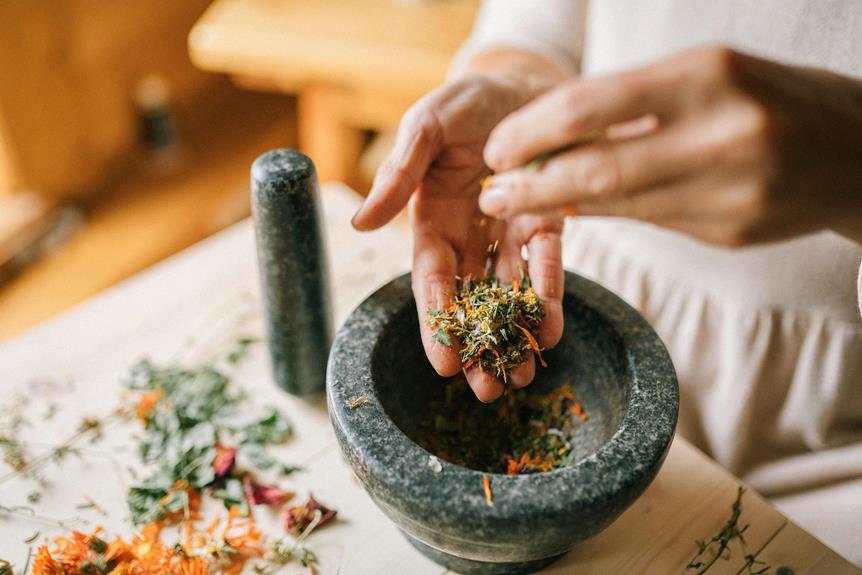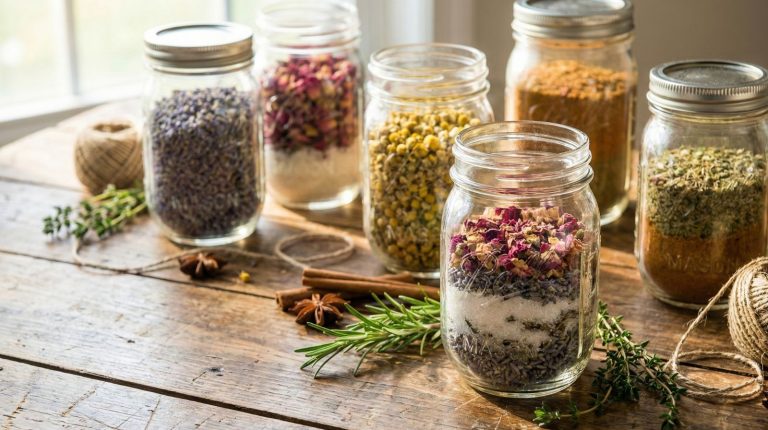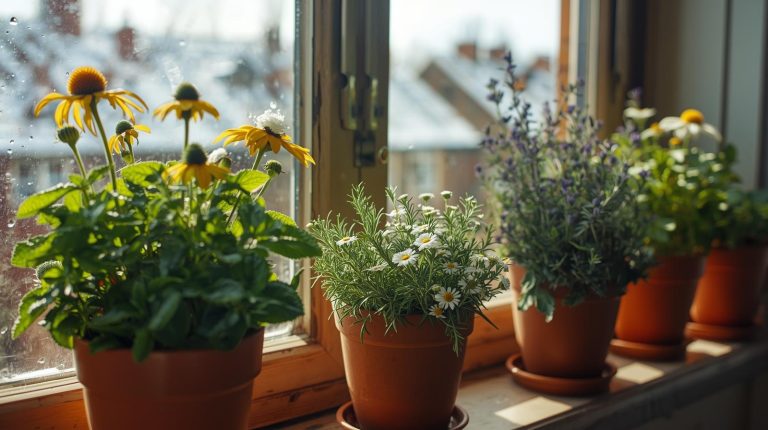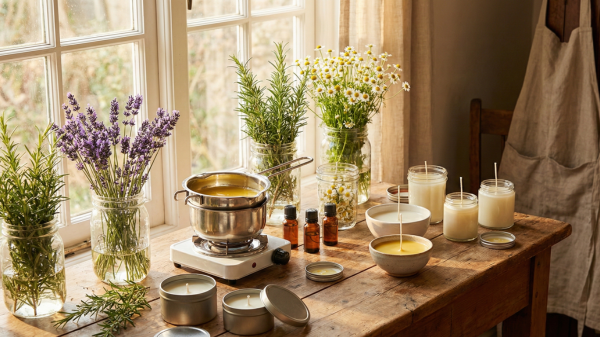In the domain of natural health, the ability to accurately identify edible medicinal plants stands as an essential skill, blending botanical knowledge with practical survival expertise. That’s why we’ll be discussing a comprehensive guide to identifying edible medicinal plants for you.
Whether you are an avid hiker, a budding herbalist, or simply a curious naturalist, understanding the nuances of plant identification not only enriches one’s appreciation of the biodiversity around us but also equips individuals with the tools to harness nature’s own medicine cabinet.
However, the path to becoming proficient in this field is fraught with challenges, including the risk of mistaking harmful plants for beneficial ones. As we explore various strategies and tools to aid in this pursuit, one must consider how to integrate these skills seamlessly into daily life, ensuring both safety and efficacy in utilizing nature’s bounty.
Key Takeaways
- Utilize reliable field guides and digital apps for accurate visual identification of plants.
- Learn to recognize key visual characteristics like leaf shape, flower color, and growth patterns.
- Engage with community groups and workshops to gain practical foraging knowledge and skills.
- Perform the Universal Edibility Test to ensure the plant is safe for consumption.
- Adopt sustainable harvesting practices to preserve plant populations and biodiversity.
Understanding Plant Habitats
The diversity of plant habitats, such as Carolinian forests, wetlands, and grasslands, plays a fundamental role in the distribution and growth of various edible and medicinal plants. Each of these ecosystems supports a unique floral assembly, tailored by environmental factors and evolutionary processes.
In the lush Carolinian forests, the rich, moist soil and diverse microclimates foster a plethora of species such as wild leeks and ginseng, both prized for their culinary and health-enhancing properties. Similarly, studies on medicinal plants in these environments highlight the potential of local flora in contributing to modern healthcare practices, such as the use of ginseng showing potential anti-cancer properties.
Wetlands, characterized by their saturated soil conditions, are hotspots for nutritious aquatic edible plants like watercress and wild rice, which thrive in these water-logged environments. Understanding the ecological specifics of these areas allows foragers to safely harvest these resources, respecting their growth cycles and ecological roles.
Grasslands, with their open, sunlit expanses, support robust species like the purple coneflower and milk thistle, known for their medicinal applications. The knowledge of seasonal variations is vital in these habitats, as the phenology of plants affects their nutritional and medicinal quality.
Accurate identification and understanding of these habitats empower individuals to responsibly and sustainably engage with nature’s bounty, fostering an ethic of liberation and respect towards natural resources.
Visual Identification Techniques
Mastering visual identification techniques is vital for accurately distinguishing between edible and medicinal plants. Utilizing a reliable field guide is fundamental in this endeavor. Such guides provide clear photographs alongside meticulous descriptions, facilitating comparison of important visual characteristics. These include leaf shape, flower color, and growth patterns which are essential in recognizing various species.
For those interested in foraging medicinal herbs, understanding the specific environments and seasonal timings can greatly enhance identification accuracy.
Focus on specific identifying features is important. Observing the number of petals, the arrangement of leaves—whether opposite or alternate—and noting any distinctive markings or textures on leaves and stems can be decisive. These details are often the key to differentiating between similar species and avoiding potential misidentifications that could lead to harmful mistakes.
The environment where a plant grows also provides important clues. Many wild edible and medicinal plants have specific habitat preferences, such as wetlands or woodlands. Knowing the typical growth conditions can guide foragers towards the correct identification.
For enhanced accuracy, employ the split-page format in identification guides. This allows you to record your observations next to the corresponding species information, aiding in better retention and verification.
Always corroborate your findings with multiple sources or consult with experienced foragers or herbalists before consumption to guarantee the safety and accuracy of your identifications.
Seasonal Plant Changes
Understanding the nuances of visual identification techniques equips us to appreciate how seasonal changes can dramatically influence the characteristics and availability of edible and medicinal plants.
The transformation across seasons affects not only the growth and appearance but also the edibility and medicinal properties of plants. For instance, Winter Crest is most beneficial when harvested in early spring, prior to flowering, as it retains peak taste and nutritional value during this period.
As the seasons progress, temperature fluctuations impact plant biochemistry. In spring and summer, young Oxeye Daisy leaves are preferable for their lesser bitterness, contrasting with the more bitter mature leaves. This underscores the significance of timely harvesting to maximize both palatability and medicinal benefits.
Additionally, the presence and blooming periods of plants like Jack-in-the-Pulpit and Common Ragweed delineate specific foraging times. These plants not only dictate seasonal foraging strategies but also highlight the need for vigilant identification to avoid toxic counterparts.
The following table summarizes key seasonal attributes of selected plants:
| Plant | Prime Season | Notes |
|---|---|---|
| Winter Crest | Early Spring | Best before flowering |
| Oxeye Daisy | Spring to Summer | Young leaves less bitter |
| Jack-in-the-Pulpit | Early to Late Spring | Harvest when blooming |
| Common Ragweed | Late Summer to Fall | Monitor for allergy implications |
This knowledge is crucial for those seeking to liberate themselves through the sustainable and safe use of nature’s bounty.
Safety in Foraging
When foraging for edible medicinal plants, it is vital to recognize and avoid toxic species, as many possess lethal counterparts resembling safe varieties.
Implementing the Universal Edibility Test is advisable; this methodical approach involves step-by-step ingestion and observation for adverse effects, thereby mitigating the risk of poisoning.
Thorough consultation with authoritative botanical resources or experts is essential to guarantee precise identification and differentiation of plant species.
Recognizing Toxic Plants
In the domain of foraging, recognizing toxic plants is paramount for safety. Familiarizing oneself with commonly encountered toxic flora, such as hemlock, is vital. Hemlock, often mistaken for edible parsley due to its similar morphological features, harbors potent toxins that can prove fatal upon ingestion. This plant exemplifies the essential need for accurate identification skills among foragers.
Moreover, a general rule to enhance foraging safety is to avoid any plant bearing white berries. These are frequently toxic and can be easily confused with non-toxic varieties. Such misidentification underscores the importance of extensive knowledge and cautious approach in wild plant consumption.
Consultation with detailed botanical guides or expert herbalists is advisable to learn the distinguishing visual characteristics between edible and toxic species. Resources should detail not only the appearance but also the specific habitat and seasonal growth patterns of these plants.
Additionally, awareness of plants like Jack-in-the-Pulpit is necessary. This species contains high levels of oxalic acid, which can cause significant irritation or harm if consumed improperly, illustrating the diverse chemical defenses plants may employ against predation.
Understanding these characteristics enhances safety and promotes a responsible foraging practice.
Universal Edibility Test
The Universal Edibility Test serves as a vital systematic procedure for guaranteeing the safety of foraged plants. This method is meticulously designed to minimize the risks associated with ingesting unknown flora.
Initially, the process demands a thorough examination to confirm that the plant in question does not appear on any toxic species lists. This precautionary step is pivotal in safeguarding against the ingestion of potentially harmful substances.
Subsequent to identification, one should engage in an olfactory assessment; a strong or unpleasant odor typically signals chemical defenses that could be harmful if consumed. If the plant passes this test, the next phase involves a dermatological evaluation.
A small portion of the plant is rubbed onto a discreet area of the skin, observing for any allergic reactions over a 24-hour period. This skin contact test is essential to confirm no immediate topical adverse effects are present.
Provided the skin shows no signs of irritation, a cautious taste test follows. Initially, only a minuscule amount of the plant is ingested, with a waiting period of 15 minutes to observe any adverse reactions.
If none manifest, one may gradually increase consumption, vigilantly monitoring for any delayed symptoms or discomfort. This gradual integration serves to meticulously validate the plant’s edibility, epitomizing cautious foraging practice.
Utilizing Identification Tools
In the pursuit of accurate identification of edible and medicinal plants, the use of thorough guidebooks is indispensable.
These guides are typically replete with high-resolution images and exhaustive descriptions that assist in distinguishing between similar species.
Additionally, incorporating knowledge from reliable research on the plants’ historical use in homeopathy can greatly enhance the accuracy of their identification.
Digital applications enhance this process by utilizing image recognition technology to offer immediate and precise identification, proving invaluable in the field.
Guidebook Features Overview
Utilizing identification tools effectively is vital for those interested in the study and use of edible and medicinal plants. A robust field guide is indispensable, featuring thorough visuals and narratives that meticulously delineate each plant’s botanical characteristics.
These guides often employ a split-page layout, fostering an interactive learning environment by enabling enthusiasts to jot down observations or queries adjacent to the detailed descriptions of species.
The precision of these guidebooks is fundamental. They meticulously illustrate and describe key visual identifiers such as leaf morphology, inflorescence architecture, and phenological patterns, which are essential in differentiating between salutary and deleterious flora.
This rigorous approach guarantees that users can confidently identify and utilize plants in their natural habitats.
Moreover, understanding the temporal patterns of plant life cycles enhances foraging success and safety. Seasonal guides within these books provide insights into when specific plants are likely to be found in their best state, thereby maximizing the efficacy and safety of foraging activities.
Lastly, consultation with veteran herbalists or seasoned foragers can augment the information provided by field guides, offering practical insights and localized knowledge that can be vital for accurate plant identification and use.
Digital Apps Benefits
Advancing beyond traditional methods, digital applications for plant identification offer a sophisticated array of features that considerably enhance the accuracy and efficiency of recognizing edible and medicinal plants. These tools are equipped with vast databases that integrate high-resolution images and detailed botanical descriptions, enabling users to distinguish edible species from non-edible counterparts with precision.
By incorporating machine learning algorithms, these applications refine their identification capabilities continuously, learning dynamically from user interactions and community corrections to reduce errors over time.
Moreover, the integration of community-driven content fosters a collaborative environment where novice foragers can gain insights from experienced herbalists, thereby accelerating their learning curve. Real-time feedback mechanisms within these apps facilitate immediate knowledge exchange, reinforcing the identification skills of the users.
Additionally, these digital tools are designed with interactive functionalities such as GPS-based location tracking and alerts about the best foraging seasons. Such features assist users in planning their foraging activities more effectively, ensuring they harvest plants at their nutritional peak.
Safety protocols within these apps also play an essential role, offering guidance on avoiding toxic species and promoting sustainable foraging practices, thereby safeguarding the well-being of the users and the environment.
Edible Plants Overview
While many regions boast a variety of flora, Eastern North America’s Carolinian forests, wetlands, and grasslands are particularly rich in edible plants, offering a plethora of foraging options. The diversity of edible flora not only provides nourishment but also holds considerable medicinal value, demanding accurate identification and an understanding of seasonal patterns for best use.
To initiate a safe and fruitful foraging journey, consider these essential guidelines:
- Proper Identification: Always use multiple sources to confirm the identity of plants. For instance, some edible plants, like wild carrots, have deadly look-alikes such as poison hemlock.
- Seasonal Foraging: Learn the best seasons for harvesting different plants. Many edible greens are best picked in early spring before they flower, guaranteeing a tender and flavorful yield.
- Knowledge of Plant Characteristics: Familiarize yourself with the specific features of plants—leaf shapes, flower structures, and growth habits are critical in distinguishing between edible and toxic species.
- Consultation with Experts: Engage with experienced foragers or utilize authoritative guides to understand not just identification but also the safe preparation and medicinal benefits of the plants you gather.
Adhering to these principles guarantees not only a liberating engagement with nature but also a safe and sustainable foraging practice.
Recognizing Toxic Plants
One must exercise caution when foraging, as certain plants, though visually appealing, can be perilous if misidentified. Among the notorious toxic plants, hemlock stands out. It closely mimics the benign Italian parsley yet contains lethal toxins. Accurate differentiation is essential; hemlock exhibits purplish spots on its stem and a musty smell, unlike parsley’s vibrant green and fresh scent.
Moreover, the allure of white berries should be approached with skepticism. Unlike the innocuous blackberries and raspberries, white berries frequently signal danger. Knowledge of berry color and associated plant characteristics is critical for safe foraging.
Additionally, plants resembling almonds may harbor hidden threats. A bitter, non-almond scent often indicates the presence of cyanide, a deadly compound. Such nuances underline the significance of olfactory examination in plant identification.
Jack-in-the-Pulpit is another plant to handle with care, due to its high oxalic acid content, which can cause significant irritation. Recognizing its distinctive hooded flowers and clustered berries can prevent unpleasant encounters.
For those seeking to liberate themselves through foraging, consulting reliable resources or experienced foragers is essential. This practice guarantees the correct identification of both edible and toxic plants, safeguarding against potential health hazards.
Sustainable Harvesting Practices
After establishing the importance of recognizing toxic plants to avoid health hazards, we now focus on the principles of sustainable harvesting to guarantee the longevity and health of foraged plants.
Sustainable harvesting not only secures the health of plant populations but also assures that future generations can continue to benefit from these natural resources.
Here are essential guidelines to follow:
- Take only what you need: Confirm that at least 50% of a plant population remains intact. This practice supports not only the regeneration of the plant species but also maintains ecological balance.
- Moderation and rotation: Harvest plants in moderate amounts and rotate your foraging locations. This prevents the depletion of any single area, allowing plant communities to thrive and sustain their roles in the habitat.
- Use appropriate tools: Employ sharp, clean tools for cutting plants, which minimizes damage and encourages healthy regrowth. Wearing gloves can protect both your skin and the plants from damage and disease.
- Understand growth and reproduction: Educate yourself on the seasonal growth patterns and reproductive strategies of the plants. Knowledge of when roots, for example, should be harvested (early spring or late fall) can greatly enhance sustainable practices.
Through these sustainable practices, foragers can harvest responsibly and maintain the health of both the plant species and the ecosystems they inhabit.
Learning From Expert Foragers
Building upon foundational knowledge of sustainable harvesting, engaging with expert foragers offers a practical avenue for deepening one’s understanding of identifying and utilizing edible medicinal plants.
Expert foragers advocate the use of extensive field guides that feature clear photos and detailed descriptions, essential for the precise identification of flora. By consulting such resources, one can discern the subtle differences between beneficial plants and those that may be extremely bitter or potentially hazardous.
Participation in local foraging workshops or community groups further enriches this learning process. These platforms enable beginners to gain hands-on experience, observing firsthand the specific characteristics and ideal harvesting techniques demonstrated by seasoned foragers.
This direct engagement facilitates a deeper comprehension of plant morphology and ecological roles, enhancing the forager’s ability to navigate the natural environment responsibly.
Additionally, interactions with experienced herbalists offer insights into the medicinal properties of plants, providing a broader context regarding their historical and cultural uses.
These experts emphasize the importance of sustainable harvesting methods that not only allow for personal benefit but also guarantee the preservation and regeneration of plant populations, fostering a harmonious balance with nature.
Conclusion
In summary, the identification of edible medicinal plants requires meticulous attention to their habitats, morphological features, and seasonal variations. Utilizing digital tools and engaging with expert foragers are vital for accurate identification and safe harvesting practices.
Proper recognition of toxic species and adherence to safety protocols, such as the Universal Edibility Test, are imperative to avoid potential health hazards. Sustainable foraging guarantees the preservation of plant populations for future generations, maintaining ecological balance and biodiversity.




